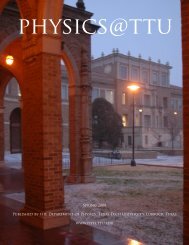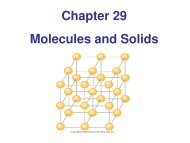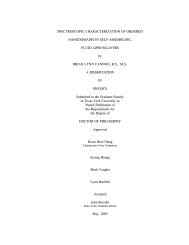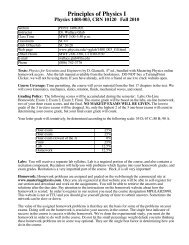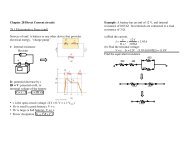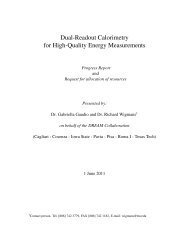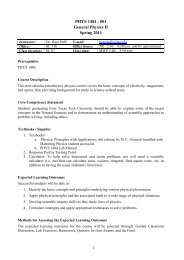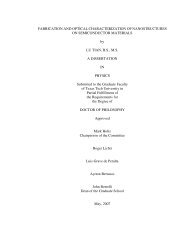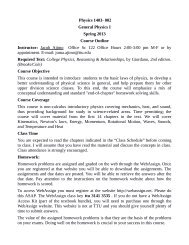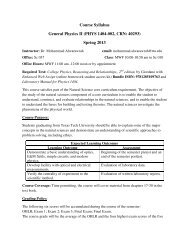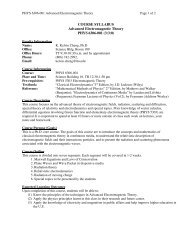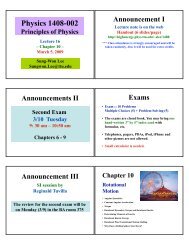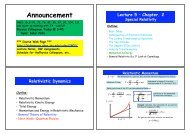Version One â Homework 1 â Juyang Huang â 24018 â Jan 16 ...
Version One â Homework 1 â Juyang Huang â 24018 â Jan 16 ...
Version One â Homework 1 â Juyang Huang â 24018 â Jan 16 ...
You also want an ePaper? Increase the reach of your titles
YUMPU automatically turns print PDFs into web optimized ePapers that Google loves.
<strong>Version</strong> <strong>One</strong> – <strong>Homework</strong> 1 – <strong>Juyang</strong> <strong>Huang</strong> – <strong>24018</strong> – <strong>Jan</strong> <strong>16</strong>, 2008 26<br />
4. Cannot be determined<br />
V r = V R + ∆V<br />
= k Q ∫ r<br />
R − Explanation:<br />
E dr<br />
We know that the potential due to a collection<br />
of N point charges is given by<br />
R<br />
= k Q R − k Q ∫ r<br />
R 3 r dr , from Eq. 6<br />
R<br />
= k 2 Q<br />
2 R + k Q (<br />
R 2<br />
2 R 3 − r 2)<br />
V = 1 ∑<br />
N q i<br />
4 π ɛ 0 r<br />
i=1 i<br />
= k 3 Q<br />
2 R − k Q<br />
2 R 3 r2 = 1 ( q<br />
4 π ɛ 0 a + −q )<br />
= 0<br />
a<br />
8. Z<br />
= k Q (<br />
3 − r<br />
2 ) ,<br />
2 R<br />
where r < R .<br />
9. M<br />
Explanation:<br />
The electric potential for R < r with<br />
the sphere conducting and/or uniformly<br />
V<br />
V ∝ 1 r<br />
non-conducting: In the region outside the<br />
uniformly charged non-conducting sphere, we<br />
G.<br />
have the same conditions as for the conducting<br />
sphere when applying the definition for<br />
the electric potential; therefore,<br />
0 R<br />
r<br />
∫ r<br />
V = − E dr<br />
keywords:<br />
∞<br />
∫ r<br />
dr<br />
Finding Zero Potential<br />
= −k Q<br />
∞ r 2<br />
25:06, trigonometry, multiple choice, < 1 min,<br />
= k Q fixed.<br />
, where R < r . (4)<br />
051 (part 1 of 4) 10 points<br />
r<br />
All of the charges shown are of equal magnitude.<br />
The electric potential for r < R with<br />
the sphere uniformly non-conducting:<br />
Because the potential must be continuous at<br />
r = R , we can use this expression to obtain<br />
the potential at the surface of the sphere; i.e.,<br />
−q +q<br />
the potential at a point on the conducting<br />
sphere is V = k Q a a<br />
r<br />
From Part 2 we found that the electric field<br />
inside an uniformly charged non-conducting<br />
(a)<br />
sphere is<br />
What is the electric potential E at the origin<br />
Assume zero potential at infinity.<br />
E = k Q r , where r < R . (6)<br />
R3 We can use this result in the definition for<br />
the electric potential to evaluate the potential<br />
difference ∆V = V r − V R (where V R = k Q R as<br />
shown in Eq. 4) at some interior point of the<br />
1. zero correct<br />
2. positive<br />
3. negative<br />
sphere, so



